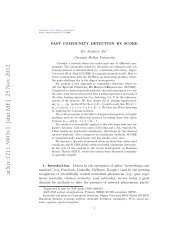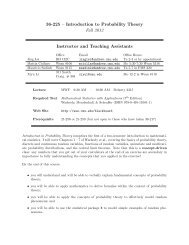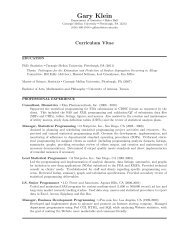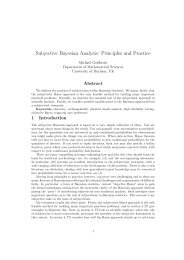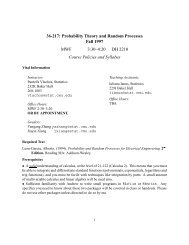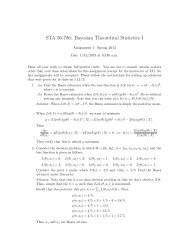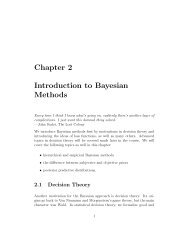A Threshold Autoregressive Model for Wholesale Electricity Prices
A Threshold Autoregressive Model for Wholesale Electricity Prices
A Threshold Autoregressive Model for Wholesale Electricity Prices
Create successful ePaper yourself
Turn your PDF publications into a flip-book with our unique Google optimized e-Paper software.
£<br />
<br />
£<br />
0.360, and 0 does not lie in the 95% credible interval. Hence a <strong>for</strong>mal test would reject the null<br />
hypothesis that mean-reversion rates are the same around spikes as at other times. We also see that<br />
the estimate <strong>for</strong> is about 0.019, which is consistent with the proportion of spikes present in the<br />
log data.<br />
¡<br />
Our results also support the hypothesis that temperature has a significant effect on electricity prices.<br />
The estimate <strong>for</strong> § (the parameter controlling the effect of temperature), as expected, is positive.<br />
The 95% credible interval does not contain 0, indicating the effect to be significant. The results <strong>for</strong><br />
the threshold parameter N indicate a mean threshold level of about 2.352 <strong>for</strong> the log price data.<br />
We are able to compare the per<strong>for</strong>mance of our model (2, 3) with that of the E&D model. We fit the<br />
E&D model and compute posterior means of parameters. We then use the posterior means from<br />
both models and compute log-likelihoods, obtaining a log-likelihood of approximately -692.832<br />
<strong>for</strong> our model, and -772.285 <strong>for</strong> the E&D model. Penalizing <strong>for</strong> the number of parameters, we<br />
compute the Akaike In<strong>for</strong>mation Criterion (AIC) of the two models ( - ¨ log-likelihood 5<br />
AIC<br />
number of parameters ) as 1397.664 <strong>for</strong> our model, and 1552.570 <strong>for</strong> the E&D model. (Note<br />
¨<br />
that our model has 6 parameters, while the E&D model has 4.) By this measure, our proposed<br />
model clearly out-per<strong>for</strong>ms the E&D model. Additional diagnostics and comparisons are given in<br />
the appendix.<br />
5 Concluding Remarks<br />
In this article, we have proposed a first-order threshold-autoregressive process with a temperature<br />
effect and a spiking component, <strong>for</strong> the logarithm of daily wholesale electricity price data. For<br />
the Allegheny County data we have considered, the model appears to fit noticeably better than the<br />
E&D model. However, we believe there are potential refinements to the model which could yield<br />
further improvement. One possibility would be to allow the spike probability ¡ to vary with time,<br />
and to depend on the price ¡ £ and temperature £ . In addition to allowing <strong>for</strong> seasonal effects<br />
in spiking probabilities and improving the fit of the model, this could yield further insight into<br />
factors which lead to high spiking probabilities. Another natural way to extend our model would<br />
be to allow <strong>for</strong> time-varying or stochastic volatility instead of constant volatility (specified by the<br />
parameter ?T ). The literature offers several alternatives along this direction (see <strong>for</strong> example, Cox<br />
et al. [6]). Also, while our non-parametric smoothing approach to estimating E £ is effective <strong>for</strong><br />
short-range <strong>for</strong>ecasting, other methods could be used. For instance, a stochastic process, such as a<br />
random walk, could be specified <strong>for</strong> YET£¦¥ itself. Additional refinements could include estimation<br />
of the jump process parameters ¢ and £ .<br />
Clearly, a useful application of this model would be in generating <strong>for</strong>ecasts. For short-range <strong>for</strong>ecasting,<br />
the mean process E£ can easily be projected into the future, although <strong>for</strong> longer range<br />
<strong>for</strong>ecasting, it would be desirable to use a stochastic process of some sort to characterize YE £¦¥ ,<br />
since this would remove the implicit assumption that the mean is known, and thus yield safer<br />
(higher variance) predictive distributions. In addition, temperature <strong>for</strong>ecasts would be required,<br />
and a separate model could be used to generate this, although in most parts of the world, fairly reli-<br />
10



